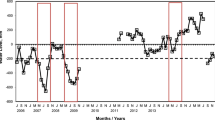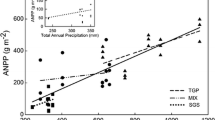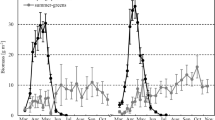Abstract
Information of aboveground net primary production (ANPP) in marshes has been limited by the lack of accurate methods for assessment. Most popular methods have weaknesses that cause either underestimates or overestimates of ANPP values. The nondestructive growth kinetics monitoring method used by Williams and Murdoch (W-M) has provided, perhaps, a most ideal and reasonable assessment of ANPP inJuncus roemerianus marshes Unfortunately, the W-M procedure is difficult to carry out and it is restricted toJuncus marshes. I present here a modification of the W-M procedure. The modified procedure applies the principle of the original W-M method while eliminating the need to monitor growth kinetics of individual plants. The modified ANPP procedure requires monthly harvests of the above-ground plant biomass over a period of 1 yr and the estimation of mean residence time of the plant. The modified W-M procedure was comparable to the original procedure inJ. roemerianus marshes of northern Florida. This modified procedure has the potential to be applied to marshes other than those dominated byJuncus.
Similar content being viewed by others
Literature Cited
Christian, R. R., W. L. Bryant, andM. M. Brinson. 1990.Juncus roemerianus production and decomposition along gradients of salinity and hydro-period.Marine Ecology Progress Series 68:137–145.
Eleuterius, L. N. andJ. D. Caldwell. 1981. Growth kinetics and longevity of the salt marsh rushJuncus roemerianus.Gulf Research Reports 7:27–34.
Hopkinson, C. S., J. G. Gosselink, andR. T. Parrondo. 1980. Production of coastal Louisiana marsh plants calculated from phenometric techniques.Ecology 61:1091–1098.
Kruczynski, W. L., C. B. Subrahmanyam, andS. H. Drake. 1978. Studies on the plant community of a north Florida salt marsh. Part I. Primary production.Bulletin of Marine Science 28:316–334.
Linthurst, R. A. andR. J. Reimold. 1978. An evaluation of methods for estimating the net aerial primary productivity of estuarine angiosperms.Journal of Applied Ecology 15:919–931.
Milner, C. andR. E. Hughes. 1968. Methods for the Measurement of the Primary Production of Grasslands. IBP Handbook No. 6. Blackwell Scientific Publications Oxford.
Smalley, A. E. 1959. The role of two invertebrate populations,Littorina irrorata andOrchelimum fidicunum, in the energy flow of a salt marsh ecosystem. Ph.D. Dissertation, University of Georgia, Athens, University Microfilm, Ann Arbor, Michigan.
Stout, J. P. 1984. The ecology of irregularly flooded salt marshes of the northeastern Gulf of Mexico: A community profile. United States Fish and Wildlife Series Biological Report 85 (7.1). Washington, D.C.
UNESCO. 1973. A guide to the measurement of marine primary productivity under some special conditions. Monographs on Oceanography Methodology. No. 3. UNESCO, Paris.
Wiegert, R. G. andF. C. Evans. 1964. Primary production and the disappearance of dead vegetation on an old field in Southeastern Michigan.Ecology 45:49–63.
Williams, R. B. andM. B. Murdoch 1972. Compartmental analysis of the production ofJuncus roemerianus in a North Carolina salt marsh.Chesapeake Science 13:69–79.
Author information
Authors and Affiliations
Rights and permissions
About this article
Cite this article
Hsieh, Y.P. Assessing aboveground net primary production of vascular plants in marshes. Estuaries 19, 82–85 (1996). https://doi.org/10.2307/1352654
Received:
Accepted:
Issue Date:
DOI: https://doi.org/10.2307/1352654




